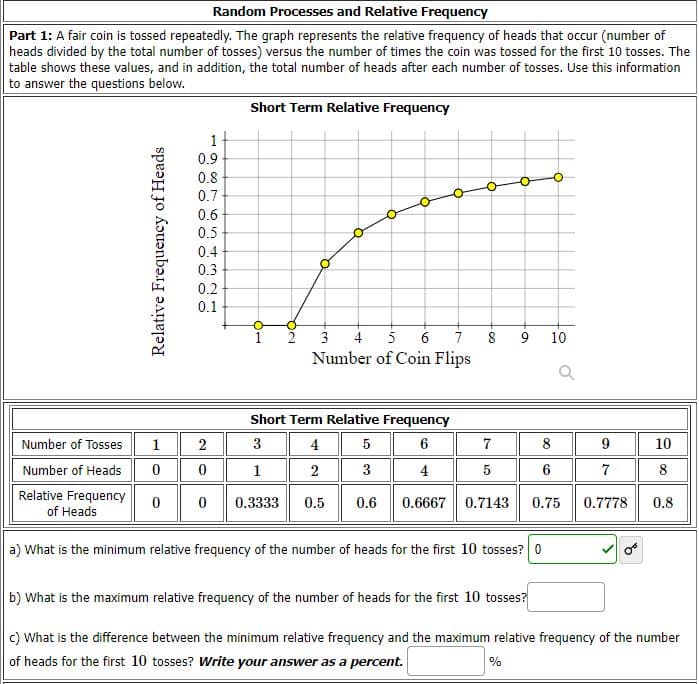a) What is the minimum relative frequency of the number of heads for the first 10 tosses? 0 of b) What is the maximum relative frequency of the number of heads for the first 10 tosses? c) What is the difference between the minimum relative frequency and the maximum relative frequency of the number of heads for the first 10 tosses? Write your answer as a percent. %
a) What is the minimum relative frequency of the number of heads for the first 10 tosses? 0 of b) What is the maximum relative frequency of the number of heads for the first 10 tosses? c) What is the difference between the minimum relative frequency and the maximum relative frequency of the number of heads for the first 10 tosses? Write your answer as a percent. %
Algebra & Trigonometry with Analytic Geometry
13th Edition
ISBN:9781133382119
Author:Swokowski
Publisher:Swokowski
Chapter5: Inverse, Exponential, And Logarithmic Functions
Section: Chapter Questions
Problem 12DE
Related questions
Question

Transcribed Image Text:Random Processes and Relative Frequency
Part 1: A fair coin is tossed repeatedly. The graph represents the relative frequency of heads that occur (number of
heads divided by the total number of tosses) versus the number of times the coin was tossed for the first 10 tosses. The
table shows these values, and in addition, the total number of heads after each number of tosses. Use this information
to answer the questions below.
Short Term Relative Frequency
0.9
0.8
0.7
0.6
0.5
0.4
0.3
0.2
0.1
2
3 4
5
7
10
Number of Coin Flips
Short Term Relative Frequency
Number of Tosses
1
2
3
4
5
6
7
8
10
Number of Heads
1
2
3
4
5
6
7
8
Relative Frequency
of Heads
0.6667 0.7143
0.3333
0.5
0.6
0.75
0.7778
0.8
a) What is the minimum relative frequency of the number of heads for the first 10 tosses? 0
b) What is the maximum relative frequency of the number of heads for the first 10 tosses?
c) What is the difference between the minimum relative frequency and the maximum relative frequency of the number
of heads for the first 10 tosses? Write your answer as a percent.
%
Relative Frequency of Heads
O76
Expert Solution
This question has been solved!
Explore an expertly crafted, step-by-step solution for a thorough understanding of key concepts.
This is a popular solution!
Trending now
This is a popular solution!
Step by step
Solved in 2 steps

Recommended textbooks for you

Algebra & Trigonometry with Analytic Geometry
Algebra
ISBN:
9781133382119
Author:
Swokowski
Publisher:
Cengage

Big Ideas Math A Bridge To Success Algebra 1: Stu…
Algebra
ISBN:
9781680331141
Author:
HOUGHTON MIFFLIN HARCOURT
Publisher:
Houghton Mifflin Harcourt

Glencoe Algebra 1, Student Edition, 9780079039897…
Algebra
ISBN:
9780079039897
Author:
Carter
Publisher:
McGraw Hill

Algebra & Trigonometry with Analytic Geometry
Algebra
ISBN:
9781133382119
Author:
Swokowski
Publisher:
Cengage

Big Ideas Math A Bridge To Success Algebra 1: Stu…
Algebra
ISBN:
9781680331141
Author:
HOUGHTON MIFFLIN HARCOURT
Publisher:
Houghton Mifflin Harcourt

Glencoe Algebra 1, Student Edition, 9780079039897…
Algebra
ISBN:
9780079039897
Author:
Carter
Publisher:
McGraw Hill